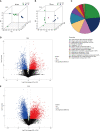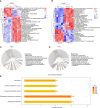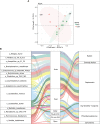The crosstalk between microbiota and metabolites in AP mice: an analysis based on metagenomics and untargeted metabolomics
- PMID: 37621874
- PMCID: PMC10446838
- DOI: 10.3389/fcimb.2023.1134321
The crosstalk between microbiota and metabolites in AP mice: an analysis based on metagenomics and untargeted metabolomics
Abstract
Background and purpose: Microbiome dysfunction is known to aggravate acute pancreatitis (AP); however, the relationship between this dysfunction and metabolite alterations is not fully understood. This study explored the crosstalk between the microbiome and metabolites in AP mice.
Methods: Experimental AP models were established by injecting C57/BL mice with seven doses of cerulein and one dose of lipopolysaccharide (LPS). Metagenomics and untargeted metabolomics were used to identify systemic disturbances in the microbiome and metabolites, respectively, during the progression of AP.
Results: The gut microbiome of AP mice primarily included Firmicutes, Bacteroidetes, Actinobacteria, and Proteobacteria, and "core microbiota" characterized by an increase in Proteobacteria and a decrease in Actinobacteria. The Kyoto Encyclopedia of Genes and Genomes (KEGG) analysis found that significantly different microbes were involved in several signaling networks. Untargeted metabolomics identified 872 metabolites, of which lipids and lipid-like molecules were the most impacted. An integrated analysis of metagenomics and metabolomics indicated that acetate kinase (ackA) gene expression was associated with various gut microbiota, including Alistipes, Butyricimonas, and Lactobacillus, and was strongly correlated with the metabolite daphnoretin. The functional gene, O-acetyl-L-serine sulfhydrylase (cysK), was associated with Alistipes, Jeotgalicoccus, and Lactobacillus, and linked to bufalin and phlorobenzophenone metabolite production.
Conclusion: This study identified the relationship between the gut microbiome and metabolite levels during AP, especially the Lactobacillus-, Alistipes-, and Butyricimonas-associated functional genes, ackA and cysK. Expression of these genes was significantly correlated to the production of the anti-inflammatory and antitumor metabolites daphnoretin and bufalin.
Keywords: acute pancreatitis; gut microbiota; metabolites; metabolomics; metagenomics.
Copyright © 2023 Zhou, Tao, Guo, Zhu, Wu, Xiang and Shang.
Conflict of interest statement
The authors declare that the research was conducted in the absence of any commercial or financial relationships that could be construed as a potential conflict of interest.
Figures







Similar articles
-
Integrating metagenomics with metabolomics for gut microbiota and metabolites profiling in acute pancreatitis.Sci Rep. 2024 Sep 14;14(1):21491. doi: 10.1038/s41598-024-72057-z. Sci Rep. 2024. PMID: 39277616 Free PMC article.
-
Tryptophan metabolite norharman secreted by cultivated Lactobacillus attenuates acute pancreatitis as an antagonist of histone deacetylases.BMC Med. 2023 Aug 28;21(1):329. doi: 10.1186/s12916-023-02997-2. BMC Med. 2023. PMID: 37635214 Free PMC article.
-
Intestinal TLR4 deletion exacerbates acute pancreatitis through gut microbiota dysbiosis and Paneth cells deficiency.Gut Microbes. 2022 Jan-Dec;14(1):2112882. doi: 10.1080/19490976.2022.2112882. Gut Microbes. 2022. PMID: 35982604 Free PMC article.
-
The Interaction of Microbiome and Pancreas in Acute Pancreatitis.Biomolecules. 2023 Dec 31;14(1):59. doi: 10.3390/biom14010059. Biomolecules. 2023. PMID: 38254659 Free PMC article. Review.
-
The Role of the Gut Microbiome in the Development of Acute Pancreatitis.Int J Mol Sci. 2024 Jan 18;25(2):1159. doi: 10.3390/ijms25021159. Int J Mol Sci. 2024. PMID: 38256232 Free PMC article. Review.
Cited by
-
Alterations in microbiome associated with acute pancreatitis.Curr Opin Gastroenterol. 2024 Sep 1;40(5):413-421. doi: 10.1097/MOG.0000000000001046. Epub 2024 Jun 13. Curr Opin Gastroenterol. 2024. PMID: 38900442 Review.
-
Causal mediation of plasma metabolomics in pancreatitis: A Mendelian randomization study.Medicine (Baltimore). 2025 Jun 6;104(23):e42557. doi: 10.1097/MD.0000000000042557. Medicine (Baltimore). 2025. PMID: 40489851 Free PMC article.
-
Updated review of research on the role of the gut microbiota and microbiota-derived metabolites in acute pancreatitis progression and inflammation-targeted therapy.Int J Biol Sci. 2025 Jan 20;21(3):1242-1258. doi: 10.7150/ijbs.108858. eCollection 2025. Int J Biol Sci. 2025. PMID: 39897025 Free PMC article. Review.
References
Publication types
MeSH terms
LinkOut - more resources
Full Text Sources
Medical

